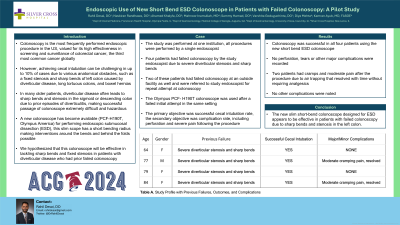Tuesday Poster Session
Category: General Endoscopy
P4148 - Endoscopic Use of New Short Bend ESD Colonoscope in Patients With Failed Colonoscopy: A Pilot Study
Tuesday, October 29, 2024
10:30 AM - 4:00 PM ET
Location: Exhibit Hall E

Has Audio

Rahil Desai, DO
Franciscan Health Olympia Fields
Chicago, IL
Presenting Author(s)
Award: Presidential Poster Award
Rahil Desai, DO1, Navkiran Randhawa, DO2, Ahamed Khalyfa, DO3, Mahnoor Inamullah, MD4, Sammy Hamad, DO5, Varshita Goduguchinta, DO1, Diya Mehta, 4, Kamran Ayub, MD6
1Franciscan Health Olympia Fields, Chicago, IL; 2Medical College of Georgia at Augusta University, Augusta, GA; 3University of Iowa, Iowa City, IA; 4Southwest Gastroenterology, a Division of GI Partners of Illinois, New Lenox, IL; 5Ascension Saint Joseph Medical Center, Joliet, IL; 6Silver Cross Hospital, New Lenox, IL
Introduction: Colonoscopy is the most frequently performed endoscopic procedure in the US, valued for its high effectiveness in screening and surveillance of colorectal cancer, the third most common cancer globally. However, achieving cecal intubation can be challenging in up to 10% of cases due to various anatomical obstacles, such as a fixed stenosis and sharp bends of left colon caused by diverticular disease, long tortuous colons, bowel hernias, etc. In many older patients, diverticular disease often leads to sharp bends and stenosis in the sigmoid or descending colon due to prior episodes of diverticulitis, making successful passage of colonoscope extremely difficult and hazardous. A new colonoscope has become available (PCF-H190T, Olympus America) for performing endoscopic submucosal dissection (ESD), this slim scope has a short bending radius making interventions around the bends and behind the folds possible. We hypothesized that this colonoscope will be effective in tackling sharp bends and fixed stenosis in patients with diverticular disease who had failed prior colonoscopy.
Case Description/Methods: The study was performed at one institution, all procedures were performed by a single endoscopist. Four patients had failed colonoscopy by the study endoscopist due to severe diverticular stenosis and sharp bends. Two of these patients had failed colonoscopy at an outside facility as well and were referred to study endoscopist for repeat attempt at colonoscopy. The Olympus PCF- H190T colonoscope was used after a failed initial attempt in the same setting. The primary objective was successful cecal intubation rate, the secondary objective was complication rate, including perforation and severe pain following the procedure.
Colonoscopy was successful in all four patients using the new short bend ESD colonoscope. No perforation, tears, or other major complications were recorded. Two patients had cramping and moderate pain after the procedure due to air trapping that resolved with time without requiring analgesics. No other complications were noted.
Discussion: The new slim short-bend colonoscope designed for ESD appears to be effective in patients with failed colonoscopy due to sharp bends and stenosis in the left colon.
Note: The table for this abstract can be viewed in the ePoster Gallery section of the ACG 2024 ePoster Site or in The American Journal of Gastroenterology's abstract supplement issue, both of which will be available starting October 27, 2024.
Disclosures:
Rahil Desai, DO1, Navkiran Randhawa, DO2, Ahamed Khalyfa, DO3, Mahnoor Inamullah, MD4, Sammy Hamad, DO5, Varshita Goduguchinta, DO1, Diya Mehta, 4, Kamran Ayub, MD6. P4148 - Endoscopic Use of New Short Bend ESD Colonoscope in Patients With Failed Colonoscopy: A Pilot Study, ACG 2024 Annual Scientific Meeting Abstracts. Philadelphia, PA: American College of Gastroenterology.
Rahil Desai, DO1, Navkiran Randhawa, DO2, Ahamed Khalyfa, DO3, Mahnoor Inamullah, MD4, Sammy Hamad, DO5, Varshita Goduguchinta, DO1, Diya Mehta, 4, Kamran Ayub, MD6
1Franciscan Health Olympia Fields, Chicago, IL; 2Medical College of Georgia at Augusta University, Augusta, GA; 3University of Iowa, Iowa City, IA; 4Southwest Gastroenterology, a Division of GI Partners of Illinois, New Lenox, IL; 5Ascension Saint Joseph Medical Center, Joliet, IL; 6Silver Cross Hospital, New Lenox, IL
Introduction: Colonoscopy is the most frequently performed endoscopic procedure in the US, valued for its high effectiveness in screening and surveillance of colorectal cancer, the third most common cancer globally. However, achieving cecal intubation can be challenging in up to 10% of cases due to various anatomical obstacles, such as a fixed stenosis and sharp bends of left colon caused by diverticular disease, long tortuous colons, bowel hernias, etc. In many older patients, diverticular disease often leads to sharp bends and stenosis in the sigmoid or descending colon due to prior episodes of diverticulitis, making successful passage of colonoscope extremely difficult and hazardous. A new colonoscope has become available (PCF-H190T, Olympus America) for performing endoscopic submucosal dissection (ESD), this slim scope has a short bending radius making interventions around the bends and behind the folds possible. We hypothesized that this colonoscope will be effective in tackling sharp bends and fixed stenosis in patients with diverticular disease who had failed prior colonoscopy.
Case Description/Methods: The study was performed at one institution, all procedures were performed by a single endoscopist. Four patients had failed colonoscopy by the study endoscopist due to severe diverticular stenosis and sharp bends. Two of these patients had failed colonoscopy at an outside facility as well and were referred to study endoscopist for repeat attempt at colonoscopy. The Olympus PCF- H190T colonoscope was used after a failed initial attempt in the same setting. The primary objective was successful cecal intubation rate, the secondary objective was complication rate, including perforation and severe pain following the procedure.
Colonoscopy was successful in all four patients using the new short bend ESD colonoscope. No perforation, tears, or other major complications were recorded. Two patients had cramping and moderate pain after the procedure due to air trapping that resolved with time without requiring analgesics. No other complications were noted.
Discussion: The new slim short-bend colonoscope designed for ESD appears to be effective in patients with failed colonoscopy due to sharp bends and stenosis in the left colon.
Note: The table for this abstract can be viewed in the ePoster Gallery section of the ACG 2024 ePoster Site or in The American Journal of Gastroenterology's abstract supplement issue, both of which will be available starting October 27, 2024.
Disclosures:
Rahil Desai indicated no relevant financial relationships.
Navkiran Randhawa indicated no relevant financial relationships.
Ahamed Khalyfa indicated no relevant financial relationships.
Mahnoor Inamullah indicated no relevant financial relationships.
Sammy Hamad indicated no relevant financial relationships.
Varshita Goduguchinta indicated no relevant financial relationships.
Diya Mehta indicated no relevant financial relationships.
Kamran Ayub indicated no relevant financial relationships.
Rahil Desai, DO1, Navkiran Randhawa, DO2, Ahamed Khalyfa, DO3, Mahnoor Inamullah, MD4, Sammy Hamad, DO5, Varshita Goduguchinta, DO1, Diya Mehta, 4, Kamran Ayub, MD6. P4148 - Endoscopic Use of New Short Bend ESD Colonoscope in Patients With Failed Colonoscopy: A Pilot Study, ACG 2024 Annual Scientific Meeting Abstracts. Philadelphia, PA: American College of Gastroenterology.

